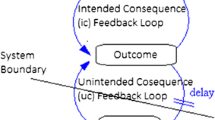Abstract
Systems approaches possess an ability to deal with large numbers of interacting variables and relations. They are here connected tocitizen information systems (distinguished frommanagement information systems) and to mixed, adaptive, conditional models for urban planning. The latter permit flexible and continuing responses to dynamically changing urban conditions, including citizen attitudes and reactions, as well as to changing economics and technologies. These models are “mixed” in that they allow actions and reactions from a multiplicity of decisionmakers. The resulting decisions are made only conditionally, rather than once-and-for-all, on a comprehensive basis as in the customary “master city plan.” Proceeding in this conditional manner, the model then permits adaptation to changing values and objectives as, at each stage, it makes the systems consequences apparent.
The systems approach is related to a host of important methodological developments in mathematics, statistics, etc., as well as in electronic computers and their use. These distinguish modern systems approaches from predecessors like the “holism” of Jan Christiaan Smuts and others in pre-war science. The mixed, conditional, adaptive models suggested here are compared with other approaches like “advocacy planning,” the “comprehensive master city plan” and “ad hoc planning.” It is found to be possible at least in principle, to accommodate all of these and even to extend matters further to include day-to-day as well as longer range facilities plans in the indicated systems approach by virtue of the improved methodologies that may now be used or developed for these purposes.
Similar content being viewed by others
References
Arnstein, S. R., Mogulof, M., Rein, M., Warren, R., and Anton, T. J., “Planning and Citizen Participation,”Journal of the American Institution of Planners,35 (July 1969) pp. 216–263.
Charnes, A. and Cooper, W. W.,Management Models and Industrial Applications of Linear Programming (New York: John Wiley & Sons, Inc., 1961).
Charnes, A., Cooper, W. W., DeVoe, J. K., and Learner, D. B., “DEMON: A Management Model for Marketing New Products,”California Management Review,XI, No. 1 (Fall 1968) pp. 31–46.
Cooper, W. W. (ed.), “Urban Issues,” inManagement Science, 16, No. 12 (August 1970).
Fromm, E., “Thoughts on Bureaucracy,” pp. B699–B705.
Branch, M. C., “Delusions and Diffusions of City Planning in the United States,” pp. B714–B732.
Eastman, C., Johnson, N. J., and Kortanek, K., “A New Approach: To an Urban Information Process,” pp. B733–B748.
Collins, J. F., “Response to ‘A New Approach to an Urban Information Process,’” pp. B749–B751.
Carr, F. J., “Urban Statistics and Their Treatment and Use for Decision-Makers,” pp. B752–B762.
Keane, M. E., “Commentary on ‘Urban Statistics and Their Treatment and Use for Decision-Makers,’” pp. B763–B764.
Terleckyj, N. E., “Measuring Progress Towards Social Goals: Some Possibilities at National and Local Levels,” pp. B765–B778.
Hoffenburg, M. “Comments on ‘Measuring Progress Towards Social Goals: Some Possibilities at National and Local Levels,’” pp. B779–B783.
Eastman, C. M., and Kortanek, K. O., “Modeling School Facility Requirements in New Communities,” pp. B784–B799.
Kane, J. “Dynamics of the Peter Principle,” pp. B800–B811.
Costikyan, E. N., “CitiesCan Work,”Saturday Review (April 4, 1970) pp. 19–39.
Davidoff, P., “Advocacy and Pluralism in Planning,”Journal of the American Institute of Planners,31 (Nov. 1965) pp. 331–338.
Eastman, C. M., and Kortanek, K., “Adaptive Conditional Approaches to Urban Planning, A Conceptual Outline,” Research Report No. 4, School of Urban and Public Affairs and Department of Architecture, College of Fine Arts, Institute of Physical Planning, March 1970.
Fitch, L. C., “Eight Goals for an Urbanizing America,”Daedalus (Fall 1968) pp. 1141–1164.
Forrester, J. W.Industrial Dynamics, (New York: John Wiley & Sons, Inc., 1961).
Forrester, J. W.,Urban Dynamics (Cambridge, Mass.: The MIT Press, 1969).
Gruchy, A. G.,Modern Economic Thought (New York: Prentice-Hall, Inc., 1947).
Harman, B. D., and Faigle, T., “Citizen Participation in Model Cities,”Urban Data Service 2, No.7 (July 1970) Washington, D.C., International City Management Association.
Hertz, D. B., and Walinsky, A., “Organizing the City to Meet New Needs and Challenges.” A report prepared, with support from the Ford Foundation, for the Institute of Public Administration, 55 W. 44th St., New York City (Oct. 1969).
Moholy-Nagy, S.,Matrix of Man (New York: Frederick A. Praeger, 1968).
Moynihan, D. P.,Maximum Feasible Misunderstanding (New York: The Free Press, Inc., 1969).
Moynihan, D. P., “The Concept of Public Policy in the 1970s.” A speech given at Hendrix College, Conway, Arkansas, April 6, 1970 (Mimeo: Washington, D.C., The White House).
Smuts, J. C.,Holism and Evolution (New York: The Macmillan Co., 1926).
Von Neumann, J., and Morgenstern, O.,Theory of Games and Economic Behavior (Princeton, N.J.: Princeton University Press, 1947).
Author information
Authors and Affiliations
Additional information
This paper was prepared for presentation before the Division 1 (General), American Psychological Association Meetings in Miami Beach, Florida on September 5, 1970.
Also, Joint Urban Sciences Information Institute, Research Report No. 5.
Rights and permissions
About this article
Cite this article
Cooper, W.W., Eastman, C., Johnson, N. et al. Systems approaches to urban planning: Mixed, conditional, adaptive and other alternatives. Policy Sci 2, 397–405 (1971). https://doi.org/10.1007/BF01406140
Issue Date:
DOI: https://doi.org/10.1007/BF01406140




